NOTE: I tend to write very long, intricate reviews, so I’m going to break this one up by posting the reviews in regular text and the “flavor text” in italics. If you just want to get right to my assessment of the toys, skip the italics. If you want to be fascinated by engaging, brilliant prose, read Tender is the Night. But if you want to read some mildly interesting commentary on the action figure industry, then by all means read the italicized text.
Back in the 1980s, Kenner produced a fondly-remembered action figure line called Super Powers, which featured DC heroes like Superman, Batman and Wonder Woman, as well as more obscure characters such as New Gods Orion and Darkseid. At the same time, Mattel–home of Barbie and the then-hugely popular Masters of the Universe line–put out a line of Marvel superhero action figures called Secret Wars.
Fast-forward twenty years. Last year, Hasbro (who absorbed Kenner in the 1990s) took over the Marvel license from ToyBiz and resumed production of its long-lived line of six-inch figures, Marvel Legends. Mattel, on the other hand, had already gotten the Batman and Superman toy rights, and last year they secured the rights to the entire DC comics pantheon. After some growing pains–their Batman line morphed into the combination Batman/Superman DC Superheroes line, and then into DC Universe Classics–Mattel hit their stride with their own six-inch superhero line. So now the roles have been reversed–Kenner/Hasbro now plasticizes Marvel superheroes for the mass market, while Mattel gives us six-inch totems of Superman, Batman, and…Etrigan?
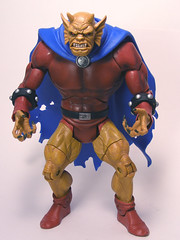 Etrigan the Demon: Since he’s a somewhat obscure character in the DC universe, I was a bit surprised when Jason Blood’s alter-ego was announced as a member of the very first wave of DC Universe Classics. He’s one of my favorite DC characters, though, so I was more than pleased he made the cut.
Etrigan the Demon: Since he’s a somewhat obscure character in the DC universe, I was a bit surprised when Jason Blood’s alter-ego was announced as a member of the very first wave of DC Universe Classics. He’s one of my favorite DC characters, though, so I was more than pleased he made the cut.
Since the line also features Orion, I wonder if this isn’t part of a conscious effort by DC to highlight the work Jack Kirby did for them. For those who don’t know, Etrigan was one of the few characters other than the New Gods that Kirby created during his relatively brief time at DC Comics in the 1970s. Between these figures and the heavy emphasis on the New Gods in DC’s Countdown and “Death of the New Gods,”DC seems to be paying tribute to the comics legend, whose name is usually associates with Marvel Comics.
Sculpt: The Four Horsemen made their name sculpting for McFarlane Toys in the 1990s, and their incredible skill is on display here. Mattel’s improved tooling and production has allowed for significant improvements in sculpts even from the revamped He-Man line earlier in the decade.
 Etrigan’s facial sculpt is excellent, possibly the best of the wave. The Horsemen have lovingly captured every crease, tooth, and horn on the Demon’s head. His clawed hands are also detailed and posed in a good demonic reach. He’s wearing his trademark red unitard with yellow tights (I think–or is that just his skin?) and red elf shoes. Go ahead, make fun of him. The last guy to do so got a face full of belched hellfire, so mock at your own risk.
Etrigan’s facial sculpt is excellent, possibly the best of the wave. The Horsemen have lovingly captured every crease, tooth, and horn on the Demon’s head. His clawed hands are also detailed and posed in a good demonic reach. He’s wearing his trademark red unitard with yellow tights (I think–or is that just his skin?) and red elf shoes. Go ahead, make fun of him. The last guy to do so got a face full of belched hellfire, so mock at your own risk.
Etrigan features a brand-new body shape–it’s not, as some predicted, a retool of Bizarro or Darkseid. The sculpt emphasizes his large torso in contrast to his relatively small legs for that “football player caricature” look. He’s also enormous–when standing straight up, he’s taller than Clayface, and has the same heft to him.
Overall, the sculpt is more detailed than the 1999 DC Direct figure, though that figure did capture Kirby’s original art a bit better. However, that’s to be expected, as the DC Universe Classics line are intended to be the Horsemen’s own interpretation of these characters, allowing for consistency across the line.
The cape is made from rubbery plastic. Other than some rips at the bottom, it’s fairly plain; some rough texture would have been nice, but that may not have cost out. Still, it’s an improvement over the DC Direct figure’s cloth cape.
If there is any problem with the sculpt, it’s that the cut joints around the thighs don’t quite match up–as if the lower part of the leg came out of the mold a bit too small. It doesn’t bother me, though.
Plastic & Paint: It’s a credit to Mattel that Etrigan’s paint applications are so good, the plastic used for most of the mold isn’t obvious. The only obvious plastic is the rubbery cape, which is a bit brighter and plainer than I might have liked.
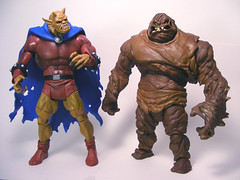 The paint applications are superb for a mass market line. Mattel seems to have figured out how to put a nice wash on a mass market toy, and it shines on this line. All the demonic details on Etrigan’s craggy face, hands and legs are brought out by the wash, which also adds just the right shadows to his unitard. The only place where the paint disappoints is on the metal bolts of his bracelets; after seeing what companies like Mezco can do with metallic textures, flat silver paint just won’t cut it anymore.
The paint applications are superb for a mass market line. Mattel seems to have figured out how to put a nice wash on a mass market toy, and it shines on this line. All the demonic details on Etrigan’s craggy face, hands and legs are brought out by the wash, which also adds just the right shadows to his unitard. The only place where the paint disappoints is on the metal bolts of his bracelets; after seeing what companies like Mezco can do with metallic textures, flat silver paint just won’t cut it anymore.
Articulation: As I’ve said before, Mattel seems to have found the sweet spot for articulation. Etrigan has ball joints at the neck and shoulders, hinge joints at the elbows, knees, ankles and abdomen, post-hinge joints at the hips (for ball joint-style range of motion), swivel joints at the wrists, biceps, thighs and waist, and slight side-to-side motion on the ankles for balance. The abdomen joint, considered a luxury by many toy companies, is important for a character like Etrigan, a demon who is usually hunched over.
Accessories: The Build-A-Figure concept has taken off in the action figure industry, and Mattel climbs on board the bandwagon with this line, featuring “Rex Mason, the Element Man”–a.k.a. Metamorpho. Etrigan comes with his left arm. I’ll review Metamorpho separately below, but his coolness as a figure is factored into this one’s as an accessory.
Other than the Metamorpho’s limb, Etrigan comes with no accessories. Since he’s such a big hunk of plastic already, I’m not surprised; however, I can’t think of a single accessory he’d carry anyway.
Overall:[raven 4]
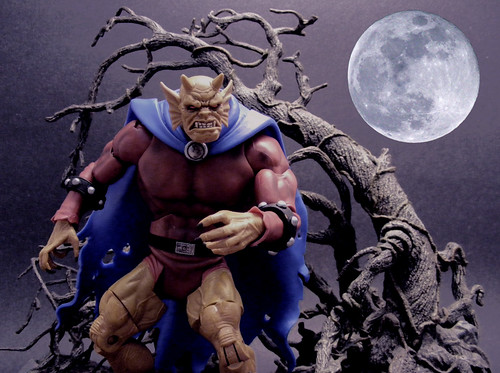
As I’ve mentioned elsewhere, I had a brief obsession with Batman when the original Tim Burton movie came out. That came and went in the midst of my Ninja Turtles period, and it wasn’t until a year or so later that I really discovered comics in the form of X-Men. Within a year or two I had lost interest in that, though, and I moved on to other interests.
But I never lost my fondness for the comic medium, which was rejuvenated when I saw the Hellboy movie in 2004. Batman Begins strengthened that interest a year later. But nothing keeps me interested in a fad like a good toy line–and my latest love is DC Universe Classics.
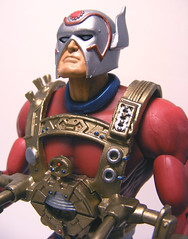 Orion: The second Jack Kirby creation in this wave (and the third for Mattel overall, after Darkseid in the DC Superheroes line, unless I’m forgetting someone), Orion is arguably the main character from Kirby’s original New Gods stories (though not the most famous–that distinction now falls to the Nixon-inspired Darkseid).
Orion: The second Jack Kirby creation in this wave (and the third for Mattel overall, after Darkseid in the DC Superheroes line, unless I’m forgetting someone), Orion is arguably the main character from Kirby’s original New Gods stories (though not the most famous–that distinction now falls to the Nixon-inspired Darkseid).
I find the whole New Gods thing really interesting. The New Gods were a group of characters created by Kirby when he moved to DC Comics. The comics were an odd mix of 1950s-style science fiction and classic superhero adventure, and the characters’ relationship to the DC Universe has always been a bit weird. While the overall concept of the series had a lot of potential, I was constantly distracted while reading the stories by some of the names, like “Mister Miracle,” “Granny Goodness,” Darkseid (pronounced “Dark-side” rather than the creepier “Dark-seed”), and especially Darkseid’s homeworld, “Apokolips.” These are the sort of names one finds in a 1980s toy-based cartoon, and they’re especially incongruous next to better names like Orion, Metron, Kalibak, and Desaad.
 The New Gods series was supposed to be a finite story with tangential connections to the DC Universe, but the series was canceled due to low sales before the story ended and the New Gods characters were absorbed into the general DC comics universe, where they’ve never quite worked (with the possible exception of Darkseid, who became one of Superman’s greatest foes). Now DC seems to be trying to close the book on them once and for all with the “Death of the New Gods” miniseries, though rumor has it at least one character will survive (my money’s on Darkseid, because he’s too valuable to DC as a member of Superman’s rogues gallery).
The New Gods series was supposed to be a finite story with tangential connections to the DC Universe, but the series was canceled due to low sales before the story ended and the New Gods characters were absorbed into the general DC comics universe, where they’ve never quite worked (with the possible exception of Darkseid, who became one of Superman’s greatest foes). Now DC seems to be trying to close the book on them once and for all with the “Death of the New Gods” miniseries, though rumor has it at least one character will survive (my money’s on Darkseid, because he’s too valuable to DC as a member of Superman’s rogues gallery).
But I digress. Orion is the greatest hero of the New Gods, the son of Darkseid but raised by the good guys on New Genesis. A determined warrior with vast powers, Orion is nonetheless cursed with a hideous face due to his Apokoliptian heritage. Most of the time, he uses his powers to hide his ugliness behind a handsome facade.
Orion is also the wielder of the Astro-Harness, a strange alien artifact with vast powers.
While Orion is a fine and welcome addition to the DCUC line, for some reason I find him a little uninspired next to the other figures in the wave. It could be because his sculpt is so simple, outside of the helmet and the Astro-Harness.
Sculpt: Orion features the same body sculpt as Batman and Red Tornado. The retooled features are his boots, his bracelets, and of course his head; otherwise, he has the most basic body sculpt of the line. There’s some nice, Kirby-esque detail on the bracelets. But I think the head is a little too wide and round, making it more of a Walt Simonson Orion than a Kirby one. The helmet is not removable, though this was probably done because a removable helmet would have looked much too large (or the head would have had to be too small). Perhaps an exclusive version in the future will offer an alternate “beaten-with-the-ugly stick” head.
Plastic & Paint: Like Red Tornado, Orion appears to have been molded in red. However, it’s a slightly darker red, with a nicer wash, and so Orion doesn’t have the toy-ish look of Tornado. The bracelets and collar are painted a shiny blue, and the red detailing on the helmet is clean.
Articulation: Standard DCUC–ball joints at the neck and shoulders, hinge joints at the elbows, knees, ankles and abdomen, post-hinge joints at the hips (for ball joint-style range of motion), swivel joints at the wrists, biceps, thighs and waist, and slight side-to-side motion on the ankles for balance.
 Accessories: This is where Orion gives you your money’s worth. While his body sculpt is simple, the Astro-Harness accessory makes the figure. It’s made from a rubbery plastic that is easily taken on and off Orion’s body. There’s a lot of intricate detailing, such as the Mother Box on his left shoulder (sadly, not removable) and the weapons near his hands, which seem to have a small amount of articulation.
Accessories: This is where Orion gives you your money’s worth. While his body sculpt is simple, the Astro-Harness accessory makes the figure. It’s made from a rubbery plastic that is easily taken on and off Orion’s body. There’s a lot of intricate detailing, such as the Mother Box on his left shoulder (sadly, not removable) and the weapons near his hands, which seem to have a small amount of articulation.
My one beef with the harness is that it doesn’t quite fit his feet properly–there’s not enough room in the back to slide over the heel. But it’s a minor issue, and Orion will stand fine in the harness.
Of course, Orion also comes with a chunk of Metamorpho (see below).
Overall:[raven 3]
Mattel has had their issues with the collectors’ market. Or perhaps I should say, the male collectors’ market. It seems to me they’ve got a good handle on people who collect Barbie dolls. But since they began dabbling in the world of adult action figure collecting, they’ve had some very mixed results. Hiring former McFarlane Toys sculptors the Four Horsemen to revamp their Masters of the Universe line for a new generation, and promoting those sculptors, was a master stroke. But production problems–from scaling issues with the figures themselves to terrible, terrible case pack-outs and distribution–dismayed collectors even as the cartoon failed to click with children, dooming the line.
When they scored the various DC licenses, Mattel wisely turned to the Horsemen again for the sculpting duties. The results, again, were mixed–for every Zipline Batman, there were at least half a dozen lame variants (“Street Luge Batman”?), while the three coolest figures in the line–Bane, Bat Signal Batman, and Attack Armor Batman–were released overseas but not in the U.S. (Wha-huh?)
 Red Tornado: Of all the characters in this wave, this is the one I knew the least about (well, aside from Metamorpho). I still don’t know much about him, other than he’s apparently some sort of android imbued with the elemental spirit of wind (?) Something like that. I’ve been trying to find out more, but DC comics are notoriously complicated these days.
Red Tornado: Of all the characters in this wave, this is the one I knew the least about (well, aside from Metamorpho). I still don’t know much about him, other than he’s apparently some sort of android imbued with the elemental spirit of wind (?) Something like that. I’ve been trying to find out more, but DC comics are notoriously complicated these days.
Sculpt: Red Tornado features the new “default” body type for the DC line. This is the body that will be used for generic, well-muscled characters–and as such, it’s the same one used for Batman and Orion in this wave. There will also be a more slender body type used for characters such as Black Manta and Nightwing, starting with the second wave.
RT has a fairly simple sculpt. As many collectors have noted, the Horsemen’s sculpts tend toward the more muscular side, particularly on their cartoon or comic figures. Their trademark seems to be large, angled shoulders, and those are present here. RT is probably slightly too buff for the character, but it’s not something I’d dwell on. It’s one thing when a superhero action figure is a little buff–it’s quite another when it’s Luke Skywalker.
The only significant sculpted details on Red Tornado’s body are the flaps of his buccaneer boots and gloves. This is the “classic” Red Tornado; there is allegedly also a modern variant who has yet to surface.
RT also features a sculpted cape with a large collar. This pretty much makes him a sure mark for a classic Martian Manhunter retool.
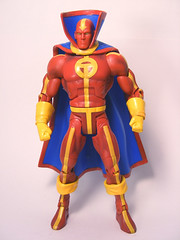 Plastic & Paint: Of the entire wave, Red Tornado suffers the most in the plastic and paint department. He’s obviously molded in red plastic and it shows; he doesn’t look like he has a red suit on, or red skin–he looks like he’s made out of red plastic. This is where a mass market figure often suffers. On a DC Direct figure, the red paint would probably have been applied, giving it a flatter, less toyish look. To save money on its huge production costs, Mattel simply molds the figure in red plastic.
Plastic & Paint: Of the entire wave, Red Tornado suffers the most in the plastic and paint department. He’s obviously molded in red plastic and it shows; he doesn’t look like he has a red suit on, or red skin–he looks like he’s made out of red plastic. This is where a mass market figure often suffers. On a DC Direct figure, the red paint would probably have been applied, giving it a flatter, less toyish look. To save money on its huge production costs, Mattel simply molds the figure in red plastic.
The figure does have a wash that minimizes the toyishness somewhat, but it’s countered by the bright, thick paint applications on the yellow stripes. Again, they tend to make the figure look a little too much like a toy, particularly since they appear to have been put on after the wash had been applied. The paint work on the cape is actually a bit sloppy.
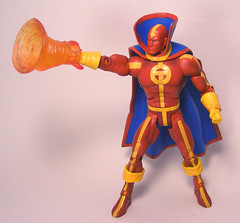 Articulation: Standard DCUC–ball joints at the neck and shoulders, hinge joints at the elbows, knees, ankles and abdomen, post-hinge joints at the hips (for ball joint-style range of motion), swivel joints at the wrists, biceps, thighs and waist, and slight side-to-side motion on the ankles for balance.
Articulation: Standard DCUC–ball joints at the neck and shoulders, hinge joints at the elbows, knees, ankles and abdomen, post-hinge joints at the hips (for ball joint-style range of motion), swivel joints at the wrists, biceps, thighs and waist, and slight side-to-side motion on the ankles for balance.
Accessories: Red Tornado comes with Metamorpho’s left leg. But he also comes with his own accessory: a little clear orange mini-tornado that can snap onto his hands.
Not knowing much about the character, I can’t speak for how accurate the accessory is, but it looks cool.
Overall:[raven 3]
See more photos of Red Tornado
When the Batman line morphed into the DC Superheroes line, things slowly began to improve. Mattel re-released earlier, hard-to-find figures such as Bane and Mr. Freeze with added articulation. Then along came wave two’s Superman–in my opinion, one of the finest action figures I’ve ever owned and a milestone in action figure history. This quote from my review sums up my feelings: “I haven’t actually “played” with an action figure since the late eighties…However, I find myself bringing this figure into my living room while watching television or hanging out with my girlfriend, posing him in various positions – flying, smashing a wall, kneeling beneath the assault of an imaginary Kryptonite block, hovering in space. This is everything an action figure should be, and the Four Horsemen and Mattel should be proud.”
Each successive wave of figures has kept that magic for me. This hasn’t happened with a lot of the other toys I’ve bought (most notably Marvel Legends or Legendary Comic Book Heroes). And I have a few thoughts as to why.
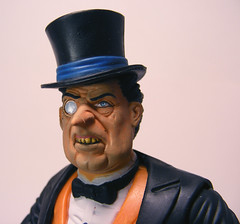 The Penguin: The Penguin is an interesting member of Batman’s rogues’ gallery. He’s well-known thanks to Burgess Meredith’s hammy portrayal on the 1960s Batman TV show, but in the comics he hardly has the status of such Bat-foes as the Joker, Two-Face, Catwoman or even Man-Bat. In fact, in the comics nowadays the Penguin mostly just runs a self-named nightclub and serves as the underworld’s information broker. I think this is a great role for the character, but it doesn’t exactly make for life-and-death struggles with the Dark Knight.
The Penguin: The Penguin is an interesting member of Batman’s rogues’ gallery. He’s well-known thanks to Burgess Meredith’s hammy portrayal on the 1960s Batman TV show, but in the comics he hardly has the status of such Bat-foes as the Joker, Two-Face, Catwoman or even Man-Bat. In fact, in the comics nowadays the Penguin mostly just runs a self-named nightclub and serves as the underworld’s information broker. I think this is a great role for the character, but it doesn’t exactly make for life-and-death struggles with the Dark Knight.
Nonetheless, he’s probably the most iconic Batman villain who had yet to be sculpted by the Four Horsemen. He’s also a fondly-remembered favorite from DCUC’s spiritual predecessor, Kenner’s Super Powers, so it’s no surprise he turned in DCUC wave one.
Sculpt: Some fans were disappointed with the vaguely grotesque look of the Penguin’s face, with some likening it to the work of Mike Mignola (to me that’s a compliment, but I digress).
The best thing about the Penguin’s sculpt–aside from the Horsemen’s usual attention to detail–is his squat, stout body shape. For the most part, Mattel and the Horsemen are trying to maximize the number of characters they can make by creating just a few different body types, then retooling the bodies to make different characters. This works very well for superhero toys, since Batman, Superman, Red Tornado and Green Lantern all wear pretty much the same skintight Spandex and have roughly the same build. So far there appears to be five body shapes in DCUC: generic muscular (CS Batman, Orion, Red Tornado, Green Lantern); slender muscular (Black Manta, Nightwing, Sinestro); teenager (Robin); stout (Penguin) and friggin’ huge muscular (Etrigan).
Somehow, I doubt they’re going to find much re-use for the Penguin sculpt…how many other squat, fat, well-known characters are their in the DCU? I can’t even think of one off the top of my head…
 Plastic & Paint: The Super Powers Penguin was famous for his bright blue tuxedo jacket and top hat, blinding yellow cummerbund and purple pinstripe pants. The Horsemen have calmed his wardrobe down a bit, giving ol’ Oswald Cobblepot a more respectable black jacket and hat. He still retains some of his outlandishness with a bright orange waistcoat; and the pinstriped pants remain, though they’re a darker purple and the pinstripes are actually painted on this time.
Plastic & Paint: The Super Powers Penguin was famous for his bright blue tuxedo jacket and top hat, blinding yellow cummerbund and purple pinstripe pants. The Horsemen have calmed his wardrobe down a bit, giving ol’ Oswald Cobblepot a more respectable black jacket and hat. He still retains some of his outlandishness with a bright orange waistcoat; and the pinstriped pants remain, though they’re a darker purple and the pinstripes are actually painted on this time.
The jacket is a separate piece (not including the sleeves) of soft, pliable rubber that fits over the waistcoat, giving a more realistic impression of clothing.
The paints have been applied well, with little to no slop anywhere. I was particularly impressed by the detailed work on the head, such as the shiny, yellowed teeth, the golden monocle, and the bright blue eye.
Articulation: Oswald has the least articulation of the wave. He has a ball jointed neck and ball jointed shoulders; hinge joints at the elbows, knees and ankles; and peg joints at the biceps, wrists, and waist.
The hips I’m not so sure about. They appear to be simple hinge joints, but I’m not convinced that they aren’t composed of the hinge half of a post-hinge joint–meaning they do have some very little motion from side-to-side, but it’s mostly restricted by the coat. The same goes for the ankles–they don’t seem to have the same side-to-side motion as the rest of the line, but there might be a little there. In any event, I think there’s enough articulation for the character–the Penguin isn’t known for his spinning roundhouse kicks or doing the splits.
Accessories: The Penguin comes with his usual part of Metamorpho and his trademark umbrella, which is painted in black and silver to resemble a gun. There’s also a Gatling-style gun attachment that clips onto the umbrella’s handle, but the nitpicking nerd part of me wonders how the gun is supposed to work. It doesn’t have its own handle, so presumably it’s supposed to shoot through “holes” on the umbrella–but how? Does it use synchronization gear like the machine guns on WWI fighter planes, which were designed to fire between the propellers?
It’s an awesome-looking accessory, but trying to figure out how it’s supposed to work keeps me up at night, tossing and turning in fevered dreams.
Overall:[raven 3.5]
See more photos of the Penguin
Toy Biz raised the industry bar sky-high for what could be done with action figure articulation in the six-inch scale. Their first high-profile experiment in super-articulation was the “Blade with Anti-Vampire Weapons” figure in their toy line based on the 1998 Wesley Snipes movie. That figure had ball-jointed shoulders, articulation at the wrists and ankles, and–gasp!–articulated toes. Two years later, Toy Biz released their Spider-Man Classics line, which featured a Spider-Man with over thirty points of articulation, including the famous double-hinge joints at the elbows and knees, which allowed the figure to bend its forearm almost parallel to the bicep, or the calf to the thigh.
Many collectors loved this amazing articulation, which allowed for countless poses and interesting dioramas. Others thought it was just too much articulation, weakening the figure as a whole and making it prone to increased quality control problems; and some even thought the joints were too obvious and ugly, detracting from the quality of the sculpt.
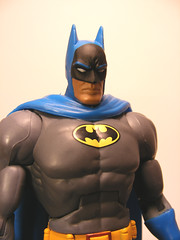 Classic Detective Batman: Since obtaining the Batman license in 2003, Mattel has not been shy about putting out Batman after Batman, from the well-received but under-articulated Zipline Batman to lame variants to the excellent DCSH gray-and-black Bats. I’d argue that the latter is the definitive Batman action figure (for now…), but it has a strong rival in Classic Detective Batman.
Classic Detective Batman: Since obtaining the Batman license in 2003, Mattel has not been shy about putting out Batman after Batman, from the well-received but under-articulated Zipline Batman to lame variants to the excellent DCSH gray-and-black Bats. I’d argue that the latter is the definitive Batman action figure (for now…), but it has a strong rival in Classic Detective Batman.
The DCUC line is taking its cue from the Super Powers line, so it’s not surprising we’re getting a very Super Powers-esque Batman in the first wave. This is the Batman my generation remembers from their youth, the one from the 1970s and 1980s who was featured on the Super Friends cartoon and so forth. From the bright blue trim to the yellow oval on the chest, this is the “New Look” Batman that dominated from 1964 to the mid-1990s.
Sculpt: Batman has the same body sculpt as Orion and Red Tornado, but with unique tooling for the gauntlets, boots, cape, belt, and of course, head.
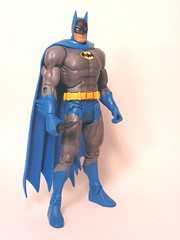 A lot of collectors were unhappy with the headsculpt on the DC Superheroes Batman, and many swapped on the head of the DC Direct Hush Batman. I don’t understand all the dislike for the DCSH head–I like it a lot; it has a gritty, Frank Miller-esque vibe to it (yes, Monkey Boy, I’ve come ’round to your opinion on the matter). Fortunately, fans seem more pleased with this head. The “ears” are thick and not too long, and the look of angry concentration on Bruce’s face is well done.
A lot of collectors were unhappy with the headsculpt on the DC Superheroes Batman, and many swapped on the head of the DC Direct Hush Batman. I don’t understand all the dislike for the DCSH head–I like it a lot; it has a gritty, Frank Miller-esque vibe to it (yes, Monkey Boy, I’ve come ’round to your opinion on the matter). Fortunately, fans seem more pleased with this head. The “ears” are thick and not too long, and the look of angry concentration on Bruce’s face is well done.
Neal Adams is considered by many to be the definitive Batman artist of the “New Look” era, and I’d like to think that the Horsemen’s sculpt was at least partially inspired by his art. Truthfully, though, this is just a great generic Batman–I’m not sure there’s any specific aspect of the sculpting that’s reminiscent of Adams’ work.
Plastic & Paint: For the most part, I like what’s been done here. Initially I’d hoped the figure would be a lighter shade of gray, more in line with its Super Powers counterpart, but the dark gray has grown on me (particularly since it more closely resembles Adams’ work). There’s a nice wash on the body and a very slight one on the cape. The detail work on the bat-symbol is excellent–as clean as a decal but with the permanence of paint.
The shade of blue used for the trim is bright, but it’s close to the coloring that was used in the comics and cartoons of the period. The balance between the gray and the blue looks better than that of the DCSH series 3 Batman, which had an almost reverse-negative effect going on.
 My one big problem with this figure is the black on the cowl. Batman has often been drawn with that, but it’s supposed to represent a shadow–not an actual color on the cowl. The 1960s TV show made the black-colored cowl (and the silly blue eyebrows) a permanent part of the costume, and I suspect Mattel decided to go with this coloring in order to attract nostalgic fans of the show. But technically, that black paint represents an incredible dark wash. I’d have much preferred to have no paint on the cowl at all.
My one big problem with this figure is the black on the cowl. Batman has often been drawn with that, but it’s supposed to represent a shadow–not an actual color on the cowl. The 1960s TV show made the black-colored cowl (and the silly blue eyebrows) a permanent part of the costume, and I suspect Mattel decided to go with this coloring in order to attract nostalgic fans of the show. But technically, that black paint represents an incredible dark wash. I’d have much preferred to have no paint on the cowl at all.
Fortunately, the black can be removed with the careful application of a solvent such as acetone or paint thinner. With any luck, Mattel will also release a variant or exclusive without the black on the cowl.
Articulation: Standard DCUC–ball joints at the neck and shoulders, hinge joints at the elbows, knees, ankles and abdomen, post-hinge joints at the hips (for ball joint-style range of motion), swivel joints at the wrists, biceps, thighs and waist, and slight side-to-side motion on the ankles for balance.
Accessories: Bruce comes with a batarang and a grappling gun. The batarang is fine, if a little plain (my favorite is still the Batman Begins-style one that came with the DCSH 3 Batman). I didn’t think I’d like the grappling gun, but it’s actually pretty neat–it comes with a small amount of thread and you can hook it on something and hang Bats in a classic pose. And of course, there’s the Metamorpho part.
Overall:[raven 4]
I tend to fall in line with those who feel that Toy Biz/Marvel Toys’s figures–such as Marvel Legends and now, Legendary Comic Book Heroes–have just a little too much articulation. The double-hinges at the elbows and knees, while allowing for great poses, make the figure seem a little…wimpy. It’s caused by the anchor joint at the elbow, which makes the arm look just a little too long and thin. But what really detracts from most Marvel Toys figures are the huge, ugly ball joints at the hips. They definitely distract the eye from the sculpt, and they also tend not to work all that well.
I think the Four Horsemen have found the sweet spot for articulation. For me, the most important joints on an action figure are the ball jointed neck, ball jointed shoulders, and the ability to move the leg outward to the left and right as well as forward and back. The DC Universe Classics figures have all those joints, and what’s more, the clever hinge-post joint at the hips allows for a natural range of motion while minimizing the effect on the sculpt. The absence of double-hinges at the elbows preserves the figure’s look of strength and solidity, while the combination hinge/swivels at the ankles are just icing on the cake.
Metamorpho: Like Red Tornado, I don’t know much about Metamorpho–other than the fact that he’s one of the coolest action figures ever.
In an Egyptian pyramid, Rex Mason was exposed to a radioactive meteorite called the Orb of Ra which transformed him into the Element Man. He became able to shapeshift and change himself into any element found in the human body, or any combinations thereof. It was later revealed that Mason was but one of many metamorphae, created by the sun god Ra to serve as warriors in his battle against the god Apep, “the serpent who never dies.”
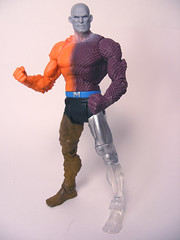 The “build-a-figure” (BAF) concept is probably the most significant innovation in the action figure industry since the Constructicons first came together to form Devastator. Popularized by Toy Biz during their Marvel Legends years, collectors have been treated to gigantic BAFs such as Galactus, a Sentinel, and Pitt.
The “build-a-figure” (BAF) concept is probably the most significant innovation in the action figure industry since the Constructicons first came together to form Devastator. Popularized by Toy Biz during their Marvel Legends years, collectors have been treated to gigantic BAFs such as Galactus, a Sentinel, and Pitt.
Here’s how it works: each character a particular wave of action figures (in this case, five figures) comes with a piece of the BAF–an arm, a leg, an accessory, and so forth. By buying all the figures, you get to build a sixth figure. This does a few things. It encourages collectors to buy all the figures in the wave, rather than cherry-picking it for their favorites; it helps justify the $10 price tag on a lot of these toys; and most importantly, it helps collectors get a figure they might never have seen at retail, either because it was too large (a separate Sentinel or Pitt in its own packaging would probably run $30-$40, much too high for most mass market retailers) or too obscure to produce, like Metamorpho here.
Unlike many BAFs, Metamorpho isn’t particularly large. (The BAFs for the next two DCUC waves, Gorilla Grodd and Solomon Grundy, are much bigger.) I’m guessing Mattel decided to make him the BAF for a few reasons: to try the concept out with a smaller figure; to allow for him to have some large accessories; and because Metamorpho may be too obscure to warrant his own figure in the line.
Incidentally, the packaging refers to him as “Rex Mason, the Element Man” rather than “Metamorpho,” despite the fact his belt has an “M” on it. This is because the name “Metamorpho” is trademarked for use on action figures by another company.
 Sculpt: Metamorpho has some of the best sculpting in the line. Not much body re-use here; because he’s the “Element Man,” he has tons of texturing, from the rockiness of his right arm to the scales of his left and the muddiness of his right leg. The transition from the Horsemen’s prototype to the retail figure has gone well, and the detailing on Rex is almost as good as what you’ll find on a specialty market figure.
Sculpt: Metamorpho has some of the best sculpting in the line. Not much body re-use here; because he’s the “Element Man,” he has tons of texturing, from the rockiness of his right arm to the scales of his left and the muddiness of his right leg. The transition from the Horsemen’s prototype to the retail figure has gone well, and the detailing on Rex is almost as good as what you’ll find on a specialty market figure.
I’m not totally in love with his head sculpt, though. Those are some big ears. But the real problem is his eyes, which I’ll get to in a moment.
Plastic & Paint: I’m going to try to be objective here. Too often I think I tend to overlook some aspects of a figure because, well, I’m just not that picky sometimes.
While the “toyish” feel of Red Tornado bugged me, I really like the orange plastic used for Metamorpho’s lava-like right torso and arm. It reminds me of the old Crystar action figure Moltar. The left leg, which blends from silver to clear, is another great touch.
Watch out for that leg left, though. Mine was a bit warped, and judging from collector comments, this is a pretty common flaw. Thirty seconds in a pot of boiling water (and be sure to hold it in there with tongs or something–if you just drop it in, it could melt against the bottom of the pot) will clear up the warping.
I love the paint work, at least in terms of color and texture. But the purple on his chest does bleed a bit too far onto the right side (though personally, I can pass this off as a natural result of his metamorphic nature), and the brown paint on the “muddy” leg is a bit too thick.
But what really weirds me out are the eyes. They’re black, with white pupils. I’ve done some image searches and haven’t found too many with good looks at Rex’s eyes, but I’m not sure whether this is a normal look for him. The beady eyes give him an inhuman aspect.
Articulation: Standard DCUC–ball joints at the neck and shoulders, hinge joints at the elbows, knees, ankles and abdomen, post-hinge joints at the hips (for ball joint-style range of motion), swivel joints at the wrists, biceps, thighs and waist, and slight side-to-side motion on the ankles for balance.
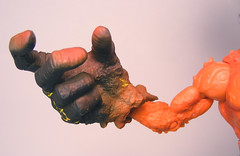 Since Metamorpho is a BAF, many of the joints aren’t as tight as they would be on the other figures in the line. The arms and legs snap into the shoulders and hips, respectively. On my figure, the left leg tends to pop out easily–and apparently this is a pretty common issue. There’s a hex-wrench-shaped disc inside the hip well that moves independent of the crotch; if you put some glue along the sides of the left leg’s peg, you can glue the leg in firmly without losing any of the articulation.
Since Metamorpho is a BAF, many of the joints aren’t as tight as they would be on the other figures in the line. The arms and legs snap into the shoulders and hips, respectively. On my figure, the left leg tends to pop out easily–and apparently this is a pretty common issue. There’s a hex-wrench-shaped disc inside the hip well that moves independent of the crotch; if you put some glue along the sides of the left leg’s peg, you can glue the leg in firmly without losing any of the articulation.
Accessories: Metamorpho features three huge accessories courtesy of his BAFhood. The first is a display base for his “muddy” leg, which his foot snaps into. The others are a lava-like giant hand for his right arm and a sledgehammer for his left. Both are sculpted to look as though they’ve grown out of his arms, rather than being accessories he’s holding in his smaller hands. The paint work on them is fantastic, especially the detailing on the “lava” hand.
Overall:[raven 4.5]
But DC Universe Classics excels in other areas as well. With some minor exceptions (Catwoman’s face, Red Tornado’s trim), the paint applications are the best I’ve seen on mass market figures and even outdo some specialty market lines. There’s very little of the glossiness that makes so many mass market figures look toyish.
The sculpting on these figures, of course, is top-notch, and thankfully, the Horsemen seem to have got Mattel to listen on the scale issue–thus we get large Darkseid, Clayface and Etrigan figures.
Even the plastic used in this line feels good to the touch–solid, and of high quality. I admit this one is hard to explain–you have to hold one in your hand to get it. However, there have been quite a few complaints about quality control on this line, so buyer beware–if you find these figures in a store, inspect the paint and joints closely before you pick them up. The only problem I have with all my figures is a slight deformity in the plastic of the right hip of my Batman–it’s not very noticeable and poses no problem to the articulation. But others have found Batmen with the right leg completely detached, or with a large gap. Other common QC problems appear to be two of the same foot or two of the same thigh on Orion, and two of the same foot on Red Tornado.
Whew. For the record, this review is about 6,000 words long–that translates to twelve pages (single-spaced) in Microsoft Office. This has to be the longest review I’ve ever written.
I’d hoped to have a special bonus feature with this review, but it didn’t pan out. I’ll update it if something changes in the future. For now, I hope you’ve enjoyed this thoroughly exhaustive look at DC Universe Classics wave one.


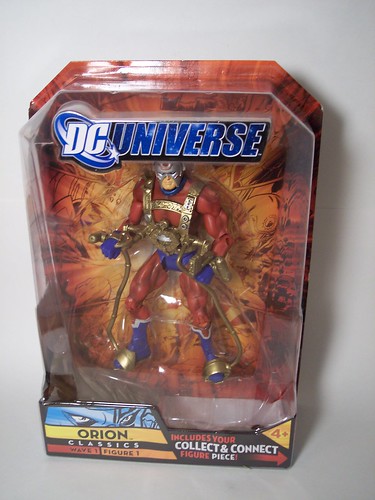
Poe
Cornerstorecomics says it will have its stock of the second wave in either today or early next week…
PrfktTear
I went to New England Comics today and they've got 30% off of most action figures, so I picked up Classic Bats and Penguin. Both are awesome!
-x
Tom-Tom
Pete, i think you can nudge the one that came with him onto his foot, and have him balance on that.
Tom-Tom
Poe: I love that episode. I liked the Batmobile they made. And I think the grappling hook that came with DCSH 1 Bats was more or less the style from HUSH.
Pete
Honestly, I'm not too familiar with the character; the design, though is classic DC. The only thing I think would make the figure completely must-have for me (other than the BAF–err, C&C piece, that is) would be some sort of tornado base for him to plug into, maybe with removable legs or something.
Poe
Thanks for the comments, all!
@Googum–It's always helpful to have someone who can be rebuilt. It's not exactly feasible to have Green Arrow get ripped in half, since that really only works once, doesn't it? Come to think of it, didn't the Vision serve pretty much the same role for the Avengers?
@Pete–I'm pretty happy with my Red Tornado, but then, I'm not a huge fan of the character. On the other hand, if I found a troubling paint mark on my Batman, I'd probably have to buy another one…
@Tom-Tom: Well, seeing as how Mythbusters proved such a device probably could never work anyway, I don't know if it really matters 😉
That said, I do kind of wish we could get a DCUC version of the explosive grapping gun Batman used in Hush.
Tom-Tom
i like the fact that you used ravens instead of stars, going with the whole edgar allen poe theme.
i dont remember which site exactly (its somewhere on my favorites), but they let you choose between two batmen and two tornados. and since the variant is essentially non-existent, i think when i order them, ill get another brucey for customs and such.
anyone else think bats' grappling hook is a bit on the big side?
Pete
Soon.
I wanted to focus on the last part of DCSH first, before prices climbed too abysmally high, but now that I've got most of it out of the way, these guys are next up on the list.
The Red Tornadoes I've seen in stores have all had one common problem; the yellow striping has streaks of red through it, as though it were badly applied, or as though the wash were applied after. It seems like a simple enough fix, though, so I'm not much bothered by it.
googum
That is one hell of a review. I'm still kicking myself for not picking the whole lot of them up at once, since now I'm scrambling for Batman, Penguin, and Red Tornado. I didn't think they would move so quickly!
In the classic Justice League of America comics, Red Tornado's main function traditionally has been, 'jobber.' He gets blown up, to show the bad guy means business, and he gets blown up, knocked down, or otherwise beaten, a lot.